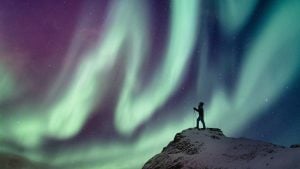

The May 2024 solar storms caused one of the most intense aurora displays in the last 500 years, sending dancing green, purple, and pink lights worldwide. The lucky ones among you who photographed the phenomenon can contribute to science with your photos. If you send them over to NASA, you can help scientists explore and learn more about solar storms.
May 2024 solar storms
The first signs of the solar storm started late on May 7 with two intense solar flares. From May 7 to May 11, multiple strong solar flares and at least seven CMEs stormed toward Earth. Eight flares in this period were the most powerful type, known as X-class, with the strongest peaking with a rating of X5.8. Since then, the same solar region has released many more large flares, including an X8.7 flare — the strongest flare seen this solar cycle — on May 14.
Traveling at speeds up to 3 million mph, the CMEs bunched up in waves that reached Earth starting May 10, creating a long-lasting geomagnetic storm that reached a rating of G5 — the highest level on the geomagnetic storm scale, and one that hasn’t been seen since 2003.
“The CMEs all arrived largely at once, and the conditions were just right to create a really historic storm,” said Elizabeth MacDonald, NASA heliophysics citizen science lead and a space scientist at NASA’s Goddard Space Flight Center in Greenbelt, Maryland.
The result – auroras!
The auroras were visible at unusually low latitudes, including in the UK, southern U.S., and northern India. The most intense auroras occurred on the night of May 10 and continued throughout the weekend, illuminating the night skies. Some folks even witnessed the phenomenon here in the Balkans!
Based on the disturbance storm time index, this recent storm is on par with the historic storms in 1958 and 2003. There have been sightings of auroras at magnetic latitudes as low as 26 degrees. This recent storm could potentially match some of the lowest-latitude aurora sightings on record over the past five centuries, but scientists are still evaluating this.
Your contribution to studying solar flares
“The CMEs all arrived largely at once, and the conditions were just right to create a really historic storm,” said Elizabeth MacDonald, NASA heliophysics citizen science lead and a space scientist at NASA’s Goddard Space Flight Center in Greenbelt, Maryland. “Cameras — even standard cell phone cameras — are much more sensitive to the colors of the aurora than they were in the past,” she added. “By collecting photos from around the world, we have a huge opportunity to learn more about auroras through citizen science.”
MacDonald said that people submitted thousands of reports to the NASA-funded Aurorasaurus citizen science site. She encourages you to continue submitting aurora reports, noting that even non-sightings are valuable for helping scientists understand the extent of the event.
“We’ll be studying this event for years,” said Teresa Nieves-Chinchilla, acting director of NASA’s Moon to Mars (M2M) Space Weather Analysis Office. “It will help us test the limits of our models and understanding of solar storms.”
Understanding how solar events affect Earth’s upper atmosphere is crucial for assessing the impact of space weather on satellites, manned missions, and Earth- and space-based infrastructure. Currently, there are limited direct measurements available for this region, but more are anticipated in the future. Upcoming missions like NASA’s Geospace Dynamics Constellation (GDC) and Dynamical Neutral Atmosphere-Ionosphere Coupling (DYNAMIC) will be able to observe and measure how Earth’s atmosphere responds to the energy surges during solar storms. These measurements will also be valuable for NASA’s Artemis missions to the Moon and future missions to Mars.
[via Digital Trends]







